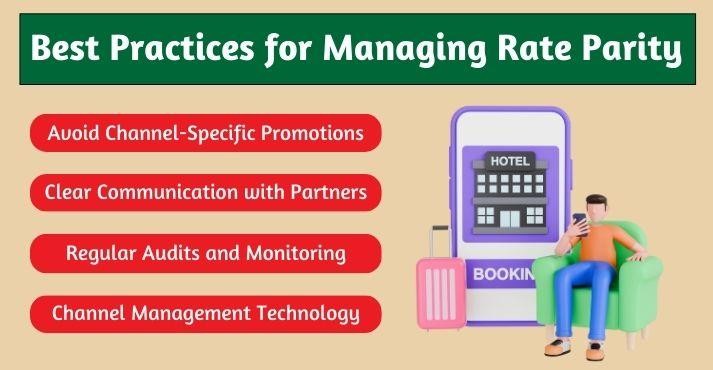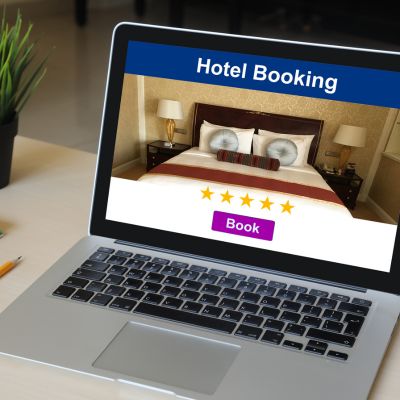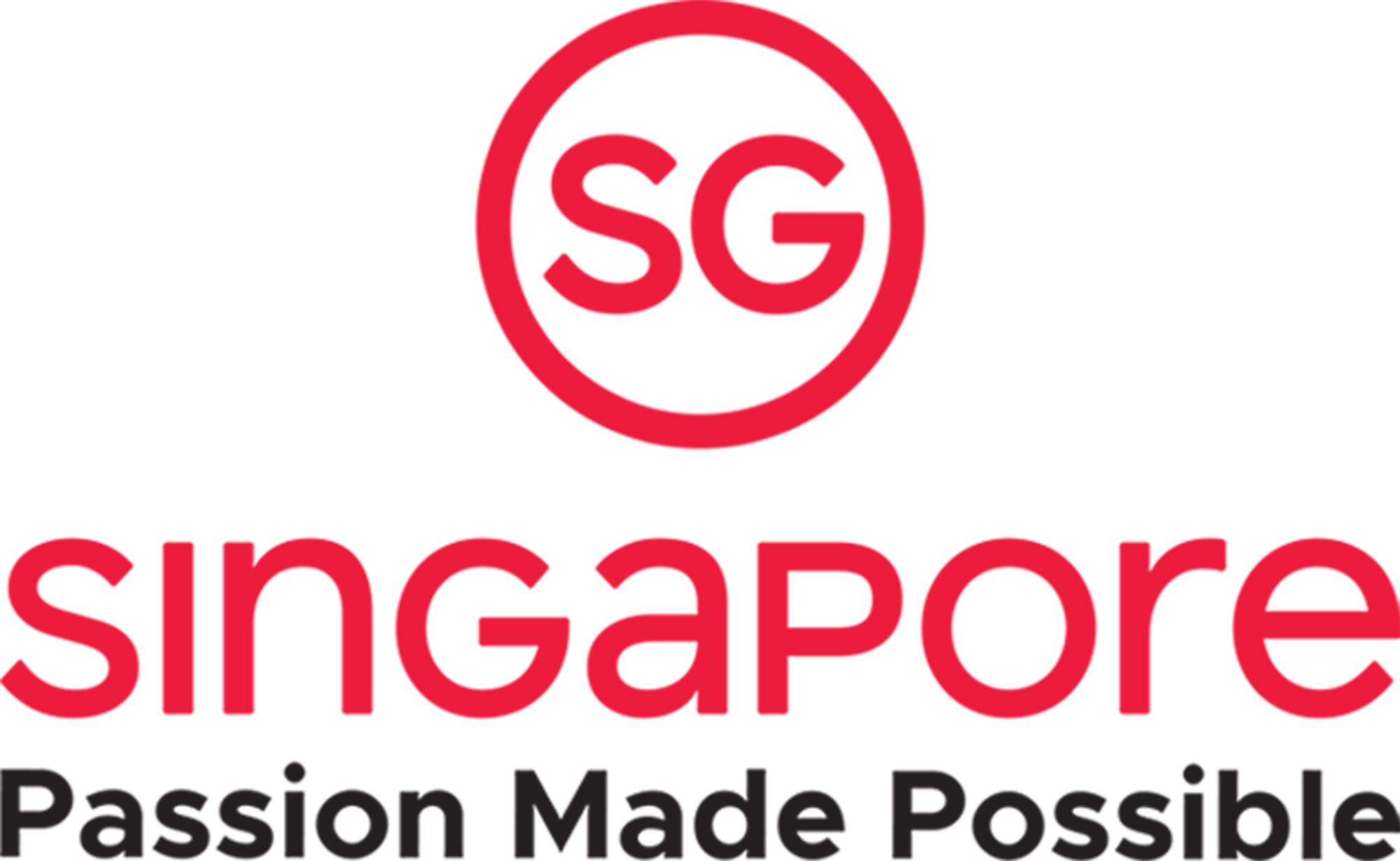Why is maintaining consistent pricing across different booking channels crucial for hotels? In today’s competitive hospitality industry, hotel rate parity is critical to ensuring fair pricing, brand integrity, and increasing guest satisfaction.
Rate parity ensures that guests encounter the same price whether booking through an OTA rate in a hotel, a hotel’s direct website, or a travel agent.
Maintaining this consistency builds guest trust, optimizes revenue, and prevents hotel rate parity issues that can erode brand reputation.
This article explores hotel rate parity, its importance, types, benefits, and strategies for effective management.
We’ll also examine real-world examples from Singapore and Southeast Asia to illustrate how hotel rate parity is applied and managed in dynamic hospitality markets.
What is Hotel Rate Parity?
Hotel rate parity refers to maintaining the same room rates across all distribution channels, including Online Travel Agencies (OTAs), direct hotel booking platforms, and other third-party booking sites.
In simpler terms, it ensures that guests see a consistent price, regardless of where they book a room. This practice, called price parity in a hotel, is essential in building brand trust and providing fair market practices.
Hotels can risk price discrepancies that drive customers away without rate parity, harm brand reputation, or lead to revenue optimization issues.
Types of Rate Parity
Hotels generally use two rate parity practices: wide and narrow rate parity. Let’s examine each:
1. Wide Rate Parity
Wide rate parity is a stricter agreement under which hotels are required not to offer lower prices than those on OTAs. This means that even if guests book directly with the hotel, they will see the same rate as on an OTA like Booking.com or Expedia.
This also means a hotel in Southeast Asia might maintain OTA price parity with an OTA, ensuring that the rate on its direct site isn’t lower than the OTA’s price.
2. Narrow Rate Parity
With narrow rate parity, hotels have more flexibility and can offer lower rates through private or offline channels, such as direct phone bookings or exclusive membership deals.
A hotel or bed and breakfast might list a lower rate for customers who book directly over the phone as long as online channels, like OTAs, maintain consistent prices.
The distinction between these types enables hotels to balance competitiveness with control over direct booking incentives while adhering to rate parity in the hotel industry.
Benefits of Hotel Rate Parity

Implementing hotel rate parity offers significant advantages, especially in building brand consistency, encouraging hotel customer loyalty, optimizing revenue, and improving channel management.
These benefits play a pivotal role in the competitive and transparent B2B hospitality market, where consistent pricing is key to maintaining guest trust and satisfaction.
1. Brand Consistency
Hotel rate parity ensures a consistent brand image, as uniform room rates across all booking platforms signal reliability and transparency.
This consistency reassures guests that they receive a fair rate, regardless of where they book. Here’s why it’s important:
- Avoids Confusion: When prices vary across OTAs, direct websites, or other third-party platforms, guests may feel uncertain or suspicious, questioning whether they’re being charged unfairly.
- Builds Trust: A hotel known for consistent pricing promotes trust, helping maintain a positive market reputation.
- Example: Marina Bay Sands in Singapore is an example of a hotel that enforces OTA price parity by offering uniform rates across platforms, thus protecting its brand and avoiding confusion that may erode guest trust.
In the B2B hospitality space, corporate clients who frequently book through multiple channels particularly value consistency.
Hotels that project a consistent image through rate parity send a message of professionalism and reliability, which is crucial for cultivating long-term business relationships.
2. Guest Loyalty
Guest loyalty is another advantage that arises from maintaining rate parity in the hotel industry. Guests are more likely to return when they experience a fair and straightforward booking process with consistent pricing. Here’s how rate parity promotes loyalty:
- Inspires Repeat Bookings: When guests see the same rates on all platforms, they’re reassured that they’re receiving a fair deal, which encourages them to book again.
- Encourages Direct Bookings: Knowing they can receive the same price when booking directly helps guests feel comfortable returning to the hotel’s website for future bookings.
- Example: Hotels like Raffles in Singapore maintain hotel rate parity to avoid confusing guests with inconsistent pricing across booking channels. This builds guest confidence, creating a sense of transparency that contributes to loyalty.
Consistent pricing allows hotels to minimize the need for frequent discounts or promotions to attract repeat guests. A straightforward approach to pricing supports guest satisfaction and keeps them coming back, as they know they’ll find fair pricing each time.
3. Revenue Optimization
Consistent rates across all channels also contribute to revenue optimization. Rate parity helps prevent hotel rate parity issues that could lead to revenue loss. Here’s how rate parity plays a role in revenue management:
- Reduces Revenue Loss: Price disparities between OTAs and direct booking platforms can result in lost bookings, as guests might feel cheated by higher rates on the hotel’s site.
- Increases Direct Bookings: When rates are equal across channels, guests are more likely to book directly, which typically offers higher profit margins than OTA bookings.
- Discourages Rate Shopping: Guests are less likely to search multiple platforms for lower rates when they know they’ll find the same price everywhere, leading to faster decision-making and more secured bookings.
When ensuring guests encounter the same rate on every platform, hotels reduce the chances of “leakage,” where potential revenue is lost to other channels.
Rate parity supports a hotel’s ability to maximize revenue, particularly when guests choose direct booking channels over OTAs.
4. Channel Management
Effective channel management is essential to maintaining rate parity, as it enables hotels to efficiently manage multiple booking platforms.
With the help of channel management technology, hotels can synchronize rates across all channels, preventing accidental discrepancies and maintaining price parity in a hotel. Key components include:
- Automated Rate Updates: Channel management tools, like SiteMinder and RateGain, allow hotels to update rates across platforms instantly, ensuring parity with minimal manual intervention.
- Centralized Monitoring: These tools provide hotels with a centralized dashboard to monitor rates, identify inconsistencies, and address any hotel rate parity issues before they impact guests.
With effective channel management, hotels can ensure that rates remain uniform across multiple OTAs, travel agencies, and direct sites.
This consistency helps hotels uphold their brand image and reduces operational complexity, as channel managers simplify the rate update process across platforms.
Strategies for Managing Rate Parity

Ensuring consistent pricing across all hotel distribution channels is a complex but essential task in today’s hospitality industry.
Hotel rate parity is vital for building guest trust, optimizing revenue, and preventing discrepancies that could harm the hotel’s brand. Here are vital strategies hotels use to maintain price parity across OTAs, direct booking platforms, and other channels.
1. Avoid Channel-Specific Promotions
One primary strategy for maintaining OTA price parity is to avoid offering exclusive discounts or promotions on specific channels. If a hotel offers a discount only on one platform—an OTA like Booking.com—it can create pricing inconsistencies that damage the brand’s credibility.
For example, suppose a hotel in Bali or Singapore runs a promotion for its direct website only. This can lead to hotel rate parity issues on OTA platforms, confusing guests who expected consistent pricing.
Instead, any promotion should be applied across all channels to avoid impacting price parity in a hotel. This approach helps maintain a consistent brand image, protects rate parity, and reduces confusion among guests, ultimately contributing to a smoother booking experience.
Channel-wide promotions also support direct bookings by giving guests confidence that they receive the best available rate, no matter where they choose to book.
2. Clear Communication with Partners
Another crucial strategy for maintaining hotel rate parity is ensuring precise and consistent communication with distribution partners. Hotels should provide OTAs, travel agencies, and corporate clients with comprehensive rate parity policies.
When sharing these guidelines, hotels reduce the likelihood of accidental rate discrepancies or undercutting on specific platforms.
For instance, many Southeast Asian hotels send periodic reminders to their partners about rate policies to reinforce rate parity in the hotel industry.
Additionally, these partnerships often include service agreements that outline penalties or corrective actions if partners do not comply with parity standards.
Clear communication and well-defined guidelines also help ensure that special rates, such as loyalty discounts or corporate rates, are used only within the intended audience and do not leak onto public platforms.
When partners understand the importance of rate parity, they’re more likely to align with the hotel’s pricing goals.
3. Regular Audits and Monitoring
Regular audits are a proactive measure that helps hotels catch rate discrepancies across all distribution channels.
When frequently checking OTA listings and third-party platforms, hotels can address any issues with price parity in a hotel before they impact guest perception or revenue.
Many hotels use monitoring tools like OTA Insight, which provides real-time insights into rates on various platforms. This allows hotels to detect inconsistencies quickly and take immediate action.
For example, hotels in Singapore routinely monitor listings on major OTAs like Agoda and Expedia to ensure rate parity with their direct booking sites.
Routine audits also enable hotels to identify trends that might indicate a recurring issue, such as unintentional discounting by a partner.
When staying vigilant with these checks, hotels can maintain hotel rate parity and safeguard their brand integrity in a competitive market.
4. Utilize Channel Management Technology
More than manual oversight is needed with numerous OTAs, booking websites, and other distribution channels. That’s where channel management technology is crucial in supporting hotel rate parity.
Advanced channel management software, such as SiteMinder or RateGain, helps hotels synchronize their rates across all platforms and automate updates when pricing changes are made.
This minimizes the risk of manual errors and reduces the time required to manage rate parity across channels.
For example, a hotel in Thailand might rely on a hotel channel manager to ensure that rates are consistent across OTAs like Booking.com, Agoda, and their direct booking site.
This centralized approach enables quick updates and prevents discrepancies from occurring on specific platforms.
Additionally, channel management tools often integrate with monitoring platforms, providing hotels an efficient solution to maintain consistent pricing across channels without exhaustive manual checks.
Challenges with Maintaining Hotel Rate Parity

While rate parity offers benefits, maintaining it comes with unique challenges.
1. Regulatory Challenges
Some countries are scrutinizing rate parity agreements for possible anticompetitive practices, which might lead to regulatory changes.
For example, European countries have restrictions on parity clauses for OTAs. In Southeast Asia, countries like Singapore are evaluating how rate parity policies affect competition in the hospitality sector. Such scrutiny could reshape how OTA price parity is implemented in the future.
2. Channel Conflicts
Conflicts between OTAs and direct channels often arise, mainly when OTAs demand competitive pricing while hotels aim to drive direct bookings.
This conflict can make it challenging for hotels to offer attractive incentives for direct bookings without violating hotel rate parity agreements.
3. Tracking OTA Compliance
Ensuring that OTAs follow rate parity guidelines is difficult, as some may offer secret deals or unadvertised discounts that bypass parity rules. Monitoring compliance is crucial, as even minor discrepancies can affect price parity in a hotel and cause customer dissatisfaction.
4. Technological and Market Evolution
The hospitality market continually evolves, with new technology and digital trends affecting booking behaviors. For instance, mobile bookings and last-minute offers often complicate parity strategies.
Hotels must adapt their rate parity approaches to keep up with these trends while ensuring hotel rate parity across platforms.
Future of Rate Parity in the Hotel Industry
The future of rate parity in the hotel industry is shifting due to regulatory changes, direct booking trends, and technological advancements.
1. Industry Trends and Innovations
The growing trend of direct bookings is influencing rate parity strategies. Hotels in Southeast Asia are increasingly focusing on developing their websites and direct booking incentives, which can reduce dependency on OTAs. This trend may lead hotels to adopt more flexible parity approaches.
2. Emerging Technology in Channel Management
AI and machine learning are becoming prominent in channel management, helping hotels optimize pricing without sacrificing hotel rate parity. Automated channel management tools help ensure consistent pricing even as booking platforms multiply and diversify.
3. Implications for Southeast Asia’s Hospitality Market
In Southeast Asia, the future of rate parity will likely involve balancing OTA relationships with direct booking strategies. As a regional hub, Singapore is setting examples of flexible rate parity practices, which are gradually influencing other countries in the region.
Conclusion
Hotel rate parity is critical for maintaining consistent pricing, brand integrity, and developing guest loyalty in the hospitality industry. Consistency across OTAs and direct booking channels helps prevent revenue loss and builds guest trust.
When implementing effective channel management and regularly auditing rates, hotels can avoid hotel rate parity issues that compromise brand trust and guest satisfaction.
As the hospitality industry evolves, rate parity practices may adapt, especially in regions like Southeast Asia, where regulatory changes and technological advancements continue to shape the market.
Ultimately, hotel rate parity remains vital to the hotel industry’s ongoing success, helping hotels provide a fair and transparent booking experience for all guests.











